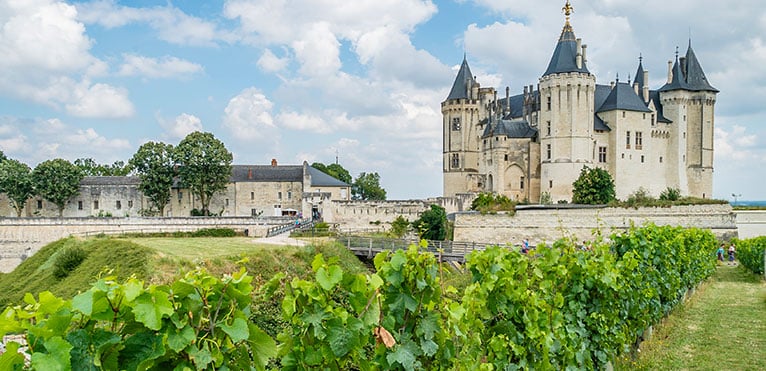
Contents
AOC Pouilly-Fumé is a white wine produced exclusively from Sauvignon Blanc grapes. Its production area is located in the Nièvre region (Loire Valley) around the commune of Pouilly-sur-Loire. Not to be confused with Pouilly-sur-Loire, which is made from Chasselas grapes.
The Pouilly-Fumé appellation has flourished since the Middle Ages
Pouilly-Fumé vineyards date back to the 5th century, but it was only in the Middle Ages, thanks to the Benedictine monks, that this wine really took off.
Following the French Revolution, peasants became owners of their land. Pouilly-Fumé is easily transported by river to Paris, thanks to the ideal location of its vineyards on the banks of the Loire. However, at the end of the 19th century, Pouilly-Fumé vines were confronted with mildew, a plant disease, and phylloxera, a vine-destroying insect. The vineyards were devastated and the plants had to be uprooted. At the beginning of the 20th century, Pouilly-Fumé enjoyed a new lease of life, and in 1937 it was awarded the appellation Pouilly-Fumé (or blanc Fumé de Pouilly), thus regaining its letters of nobility.
“Pouilly-Fumé”, like its bouquet and the appearance of the grapes.
The Pouilly-Fumé vineyard covers around 1,300 hectares and extends over the communes of Pouilly-sur-Loire, Saint-Andelain, Tracy-sur-Loire, Mesves-sur-Loire, Garchy, Saint-Martin-sur-Nohain and Saint-Laurent-l’Abbaye. Pouilly-Fumé is produced from a single grape variety, Sauvignon Blanc, which produces small, round berries. Close to Nevers, the appellation’s vines are located on the right bank of the Loire, facing south.
The vines of this appellation are planted on three types of gently undulating soils that give the wines their distinct characteristics and aromas. Winemakers either blend grapes from different soils, or isolate them. The first soil family, Kimmeridgian clay-limestone marl, is easily identified by large balls on the surface. These marls produce wines that are relatively fat on the palate and fragrant, and that should be aged for two years. Pouilly-Fumé vines are also planted on limestone soils of two types, either small pebbles or flat stones. Wines obtained from these soils are fresher and can be drunk fairly young. Finally, there are flint soils surrounded by clay or clayey-sandy mixtures. In this case, the wines produced have complex aromas and strong mineral notes, requiring a longer ageing period.
The climate in the Pouilly-Fumé production area is temperate oceanic, meaning that winters are mild and wet and summers are relatively cool.
This appellation owes its “smoky” name not only to its unique, slightly smoky bouquet, but also to the gray bloom that covers ripe Sauvignon blanc grapes.
Pouilly-Fumé rests on a terroir of varied soils that account for a wide range of aromas.
Pouilly-Fumé is pale gold in color. Like most Loire wines, the appellation’s wines release pleasant fruity and floral aromas. It is the variety of soils that explains the complexity of aromas that this terroir can bring. On the nose, we find blackcurrant or boxwood in the cris, sweet notes of narcissus in the marl and more vegetal scents in the flint. However, what makes the wines of this appellation unique on the nose are powerful aromas of musk and smoke. Although aromas vary depending on the soil, Pouilly-Fumé wines have a common olfactory denominator: citrus aromas such as lemon, orange and grapefruit, delicately blended with mint and fougère.
On the palate, wines produced on flinty soils are relatively firm and structured. Its bouquet is often described as “flinty”, that is, combining great minerality (heated flint) with smokiness (burnt powder). In the cris (limestone-laden soils), wines are more fragrant and elegant, and aromas develop rapidly. Wines from marl soils tend to be firm and, conversely, develop more slowly than those from cris soil.
Pouilly-Fumé is a dry white wine, light and round on the palate, which should be drunk young, with around two years of ageing potential. However, some vintages can be kept for up to five years.
Pouilly-Fumé, a light white to match your dishes
Since Pouilly-Fumé is a relatively light white wine with fruity, floral aromas, it goes very well with a wide range of dishes. It goes beautifully with fish and seafood, as its fruity aromas complement the fine flesh of the fish. Pouilly-Fumé can also be served with stuffed tomatoes or poultry. This wine should be served at around 10°C.
The 20th century, a great century for the Pouilly-Fumé appellation
The Pouilly-fumé appellation has four vintages of the century: 1945, 1959, 1989 and 2005. Note that 1929, 1947, 1953, 1961, 1978 and 1985 are also excellent vintages.
2 Pouilly-Fumé estates steeped in history
Joseph Mellot Estate
This Pouilly-Fumé estate is a true benchmark for Loire wines, bearing witness to the extraordinary richness of the region’s terroirs. Today, this estate is the only one present in all the appellations of the Centre Loire, and covers 105 hectares, including 25 in Pouilly-Fumé. A forerunner, it is the first French estate in the Loire to cultivate its vines using sustainable agriculture.
Domaine Michel Redde et Fils
This is a family estate that has been handed down from generation to generation, from Michel Redde, born in 1930, to his grandsons, the latest to take up the torch. They are adopting new farming methods while perpetuating a tradition of respect for the terroir and the environment (low yields and controlled organic inputs). Today, the estate covers 42 hectares in the heart of the Pouilly-Fumé AOC.